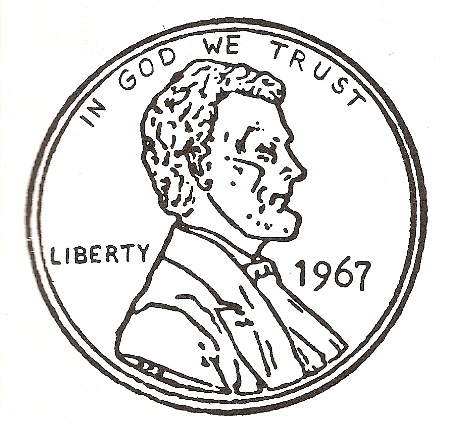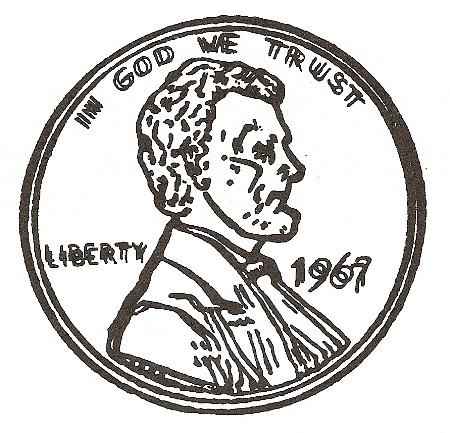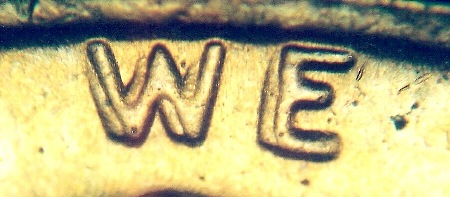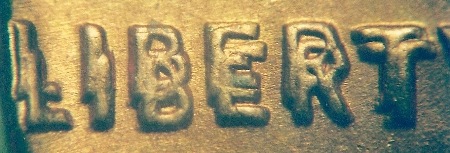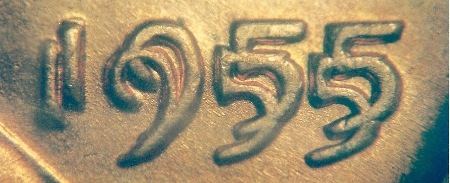


 |
 |
 |
 |
 |
 |
 |
 |
 |
 |
 |
 |
 |
 |
 |
 |
 |
 |
 |
 |
 |
 |
 |
 |
The first, and probably the most famous class of doubling on doubled die varieties, is the Class I doubled die. It is named “Rotated Hub Doubling” since the misalignment of images between the hub and the die is produced by a rotation of the hub with respect to the die. The point of rotation for the hub or die is usually the center of the hub/die, however, it could also be somewhere between the center of the hub/die and the rim. Imagine making an impression in the die, raising the hub and turning it slightly as you would turn a wheel, and then lowering the hub to make another impression in the die. The result would be overlapping images (doubled images) on the die. That is essentially how Class I doubled dies are created. If you would like to get a firsthand look as to how this works, use super glue to attach the reverse of a Lincoln cent to the end of an unsharpened pencil. This will be your working hub. You will also need some modeling clay or perhaps some silly putty. Push the Lincoln cent that is fastened to the end of the pencil into the clay to make an impression of the obverse. Once you have done this, carefully pull the Lincoln cent out of the clay, rotate the pencil very slightly and then push it back into the clay in the exact same location and to the same depth that you made the first impression. The result will be overlapping doubled images in the clay because of the slight rotation that you made prior to making the second impression. You have successfully made an example of a “working die” with Class I doubling. This is exactly what happened in the multiple-squeeze hubbing presses when Class I doubling was created on a working die. To further illustrate the effect we took a sketch of the obverse of a 1967 Lincoln cent (Figure #1) and made a transparency of the image on transparency film that you can get for computer printers. We placed the transparency image directly over the sketch and rotated it slightly about the center point of the circle and then scanned it. The result is what you see in Figure #2 below. The doubling that you see in Figure #2 is just like the doubling seen on the famous 1955 Obverse Die #1 Lincoln cent doubled die variety and the 1972 Obverse Die #1 Lincoln cent doubled die variety. Both of them are very strong Class I doubled die varieties.
Figure #1 - Here we see a normal design image for a 1967 Lincoln cent.
Figure #2 - This is a classic example of a Class I doubled die variety. It was made by making a transparency film image of Figure #1, placing it directly over the image in Figure #1, and then rotating the transparency slightly about the center point. The doubling has essentially the same spread all the way around the circumference of the image. The rotation of the hub causing the doubled impression can be in a clockwise (CW) direction or a counterclockwise (CCW) direction. Since subsequent hubbings almost always penetrated more deeply into the face of the die than the previous hubbing, the images from the subsequent hubbing will be a bit stronger than those left by the previous hubbing. As a result, it is possible to look at a Class I doubled die variety and determine whether the rotation between the hubbings was CW or CCW. Using the Lincoln cent as an example, if the misalignment was due to a CW rotation, the slightly stronger image (primary image) will be to the right of the weaker image (secondary image) on the letters of IN GOD WE TRUST. The doubled die will be said to have a CW spread to the doubling. If the misalignment was due to a CCW rotation, the primary images will be to the left of the secondary images for the same letters. The doubled die will then be said to have a CCW spread to the doubling.
Here we see an example of a CCW spread on the Class I 1972 doubled die Lincoln cent that we have listed as 1972 1¢ WDDO-002. Note how the primary (stronger) image is to the left of the secondary (weaker) image. All of the letters of IN GOD WE TRUST show the same doubling.
This is another one of the “lesser” 1972 Lincoln cent doubled die varieties. It is listed as 1972 1¢ WDDO-008. This one shows a classic CW spread to the doubling. Notice on this one that in contrast to the previous photo the primary image is to the right of the secondary image. The famous 1955 Die #1 Lincoln cent doubled die variety is without doubt the most well known example of a Class I doubled die variety. It truly is the "King of the Doubled Die Varieties." It has an exceptionally strong CCW spread to the doubling.
The incredible spread on the 1955 Obverse doubled die Lincoln cent listed as Obverse Die #1 (1955 1¢ WDDO-001) shows a major CCW spread to the doubling. The doubling is visible to the naked eye. After all of the fuss over the famous 1955 Obverse Die #1 Lincoln cent doubled die variety, the Mint took steps to prevent any doubled dies with such strong spreads from ever happening again. They began placing alignment “lugs” around the circumference of the hub and the die. On the dies these lugs took the form of raised pieces of metal. On the hubs they appeared as corresponding depressions into which the raised areas on the die would fit. Some play in the lugs could allow for minor Class I doubled dies to occur, but they would eliminate the possibility for strong spreads to occur.
Arrows point to the grooves around the circumference of a Lincoln cent working hub. These grooves correspond to the raised areas (lugs) seen around the circumference of the Lincoln cent working die seen in the next photo.
Arrows point to the lugs around the circumference of a Lincoln cent working die. These raised areas correspond to the grooves seen around the circumference of the Lincoln cent working hub seen in the next photo. In 1969 the Mint modified the obverse design for the Lincoln cent. As a result of those changes, they experienced difficulty in getting satisfactory impressions in the working dies. To remedy the problem they removed the lugs from the hubs and dies to allow for deeper penetration of the hub into the die. This did fix the problem and allowed the deeper penetration of the hub into the die, but it opened up the possibility of doubled dies being created with strong Class I spreads. It didn’t take long for the consequences of this decision to be felt. In 1969 a major Class I doubled die was produced for the 1969-S Lincoln cents. Another major Class I doubled die was produced for the 1970-S Lincoln cents. Several “lesser” Class I doubled dies found their way into production for the 1971 Lincoln cents. The dam broke in 1972 and several Class I doubled die varieties were produced for the Lincoln cents from all three Mints. The well known 1972 Obverse Die #1 Lincoln cent doubled die variety is an example of a Class I doubled die with a very strong CW spread. As already seen, 1972 produced several other “lesser” Class I doubled die varieties from all three Mints. Some of them have CW spreads while others have CCW spreads. During this period of time significant Class I doubled dies were being produced for other denominations as well, but the Lincoln cent varieties tend to be the most well known. After the flood of Class I doubled die varieties in 1972 and all of the publicity that they generated, the Mint returned to the practice of placing the lugs around the hubs and dies. Because of the set-up of the hub and die in the single-squeeze hubbing presses, rotational movements between the hub and the die are still possible as the single-squeeze is taking place. Mint employees have also been known to stop a hubbing press before a single-squeeze hubbing has been completed, reset the hub and die, and then finish the hubbing process. When this happens, the possibility of a rotational misalignment can occur. The strong rotational doubling seen on the reverse of the 2009-D District of Columbia quarter listed as 2009-D 25¢ DC WDDR-001 is an example of this type of event taking place.
The major doubling seen on the reverse of this 2009-D District of Columbia Washington quarter was confirmed by the Mint to be caused by a rotational misalignment after the hubbing press operator stopped the single-squeeze hubbing press, reset the hub and die, and then restarted the hubbing press. To prevent Mint hubbing press operators from making similar alignment errors locks have been placed on the hubbing presses to prevent hubbing press operators from restarting the press until a supervisor comes to inspect and make sure that everything has been realigned properly. Class I doubled dies varieties remain a favorite among collectors of doubled die varieties, probably due to the fact that the rotational misalignments will produce doubling over most of the obverse or reverse design. Many of the most popular doubled die varieties fall into this class of doubling. Go To: | ||


